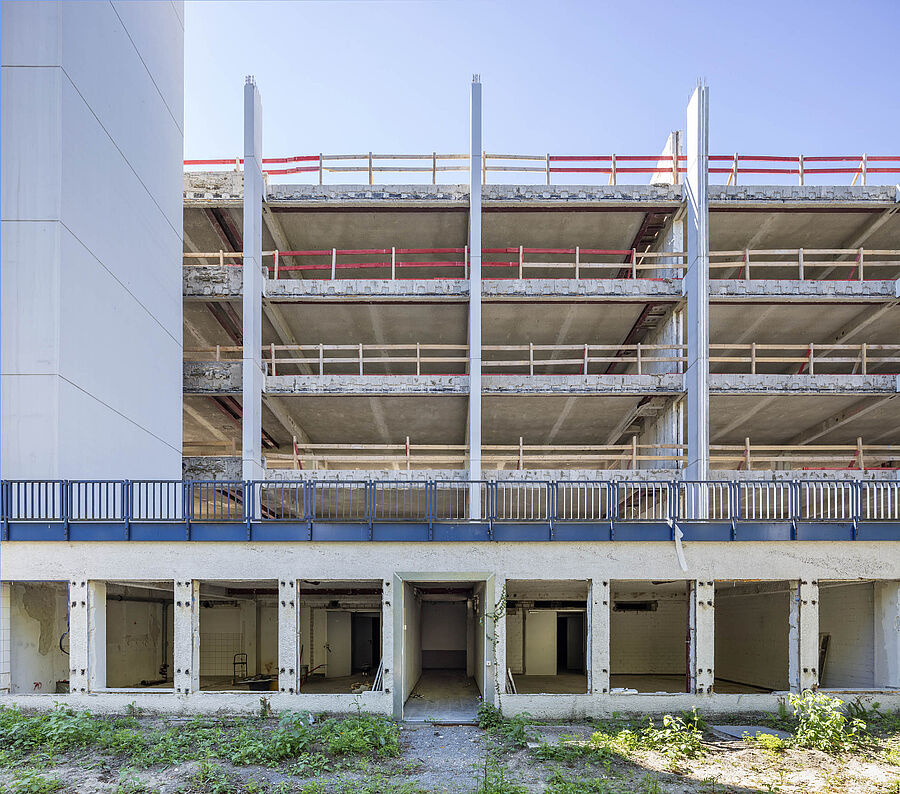09/02/2022
Construction in existing contexts
Adding value to the existing
Ambitious goal: The Climate Protection Law stipulates that greenhouse gas emissions in Germany must be reduced by 65% by 2030 compared with 1990 levels and that climate neutrality must be achieved by 2045 (source: German government). Added to this are the goals of the Paris Climate Agreement to limit global warming to a maximum of 2 degrees and, if possible, 1.5 degrees (source: Federal Environment Agency).
The building sector plays a crucial role in achieving these climate goals. Construction in existing contexts can be one approach to a solution. There is enormous potential for CO2 savings in the preservation, further use and conversion of existing buildings and building materials. The grey energy, i.e. the energy bound in the building that was used for construction, production and transport, thus remains bound in the existing building structure due to the building materials already used. Consequently, the sustainability of a building depends not only on the current energy consumption, but also on the grey energy already bound in the construction. The deconstruction and new construction of a property consumes a considerable amount of energy. In a new building, the grey energy accounts for about 50% of the energy consumption in the life cycle (KfW55) (source: Bauwende). Consequently, a high CO2 savings potential lies in the modernization of real estate. These can be reused in a progressive way through maintenance, renovation or conversion to future-oriented requirements. Building in the existing contexts offers the opportunity to make a building or an urban space fit for the future.
In addition to the climate goals, the German government also has a goal of creating 400,000 affordable and climate-appropriate housing units each year (source: German government). In times of housing shortage, it is necessary to strive for the care, maintenance and continued use of existing structures. Buildings can thus be given a second life and new functions through sustainable conversion.
Equally important is the energy-efficient refurbishment of existing properties. Calculations by the Research Institute for Thermal Insulation suggest that greenhouse gas emission targets can only be met by increasing the modernization rate to at least 2% per year (source: Research Institute for Thermal Insulation e.V. Munich). At present, the current refurbishment rate is only about 1% (source: Federal Environment Agency). Consequently, the annual refurbishment rate must be increased significantly. In July 2022, the Ministry of Economics realigned the federal funding for efficient buildings (BEG). Anyone wishing to receive funding for a complete refurbishment should contact the state development bank KfW. In order to enable as many applicants as possible to receive funding, KfW's BEG funding rates have been reduced (since 08/15/2022). The Federal Office of Economics and Export Control (BAFA) is responsible for individual measures such as replacing windows, doors, heating or renovating the building envelope.
CONCLUSION
Before demolishing or constructing a new building, the question should always be asked: What can the existing building do and how can we use it in the future? Existing potentials should be used and qualities strengthened. Architecture is also a testimony of time that is worth preserving and can be given a new life cycle. In order to contribute to the achievement of climate protection goals, it is essential to enhance the value of existing buildings and to modify them for today's uses. Sustainable construction does not exclusively mean building new structures, but also preserving and adding value to existing buildings.
Our examples:
Goldsteinstrasse, Frankfurt am Main, Germany
Heinrichstrasse, Düsseldorf, Germany
